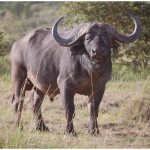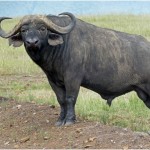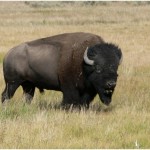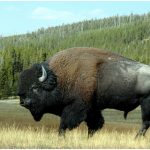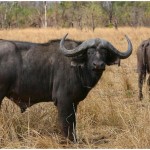The buffalo is a large ruminant mammal found in Africa and Asia, belonging to the bovidae family, which includes species like the water buffalo and the African buffalo. The African buffalo is closely related to other large bovines. It is also regarded as a large African bovine. It is highly dangerous to man because of its unpredictable nature.
It has never been domesticated unlike the water buffalo. The African buffalo is a very robust species. Buffalos are either in two forms, wild and domestic. The African buffalo’s significance is tied to its appeal to both hunters and tourists.
Also read:
Buffalo Facts
When Americans come across the word buffalo, their mind probably goes to the America bison. Buffalo originally referred to the water buffalo (introduced to the Western Europe from Asia) and other large bovid animals of Eurasia and Africa. The history of Buffalo begins with the Greek word boubalos known as antelope. The Romans later borrowed this word as bubalus.
However, the Latin came and reformed it into bufalus and it became the name for the water buffalo when it was introduced to the Europeans. Bufalus transformed into buffalo in Italian. Later in 1625, buffalo were used to describe the bison of America by English writers. More to this …
- The buffalo is very strong
- The buffalo is dangerous to man
- The buffalo likes to move around a lot
- The buffalo live only in a small number of protected areas
- The buffalo can also be domesticated
- The buffalo spends much of their day submerged in muddy water
- The male buffalo has enormous backward-curving, crescent-shaped horns stretching to 5feets.
- The female buffalo is smaller in size and weight
- A buffalo is very robust
- A buffalo is intelligent
- A buffalo is self confident
- They are sometimes stubborn
- The buffalo is often used for transportation
- The height of a buffalo is relative to a 6-ft
- The skin of a river buffaloes is black but some specimens varies in color
- They have longer faces, smaller girth and bigger limbs
- A buffalo horn grows outward and curve in a semicircle
- The neck of a buffalo is comparatively long
- The tail is short
- The dorsal ridge of a buffalo extends further back and tapers off more gradually.
Buffalo Diet
The buffalo is often robust and large. So it has huge appetites. Buffalos are ruminant animal which means they have to use micro organism in the rumen to digest the feed. They usually feed on vegetables by grazing. The feed enters the rumen compartment when swallowed. The buffalo goes around feeding on grasses and other animals. The feeds taken in by the buffalo contains various nutrients like protein, carbohydrate, minerals and water.
Habitat
The buffalo lives in areas with enough grass and vegetation to graze on. It also lives where there is access to water and shade as well. Therefore, these regions could include the savannas in Africa where their needs are met to a great extent.
Behavior
In behavior, the buffalo is regarded as being a dangerous animal. Several people are killed by the buffalos each year. While humans are predators of buffaloes, they also face natural threats from animals such as lions, leopards, and spotted hyenas. On average, the buffalo is active throughout the day and night because they spend 18 hours a day searching for food and moving around.
Lifestyle
The buffalo requires daily movement from one place to another in search of feeds. Therefore it leads quite a busy lifestyle as compared to other animals like cattle. They are herbivores so they don’t require much care. They move around to find their food.
Lifecycle
The mating season starts either at the beginning of spring or at the end of summer. After a gestation period of around 11 months, the females give birth to calves, which are nursed for about 7 months. They begin grazing almost immediately helping greatly on their growth. The bull becomes reproductive in six years while the cow, after two years. On average, a buffalo has a lifespan of about 20 years.
Predators
The buffalos are large animals. This gives them the advantage of having few predators. They include the human, lions, leopards and hyenas.
Breeding
When males reach 2years of age, they leave their mothers but females stay with their mother until they have produced their own offspring. The mating begins early summer to have them give birth after 11 months of gestation.
Appearance
The buffalo is a robust animal. It stands tall at the shoulder, wild and formidable. They are mostly dark brown or black in color.
Life Span
An average buffalo can live to between 18-20 years. However, they can live up to 30 years. This is possible if they keep away from danger and learn survival tactics.
Health Issues
The Buffalo is generally healthy compared to other animals. It is very interesting because most of them live in hot, humid regions that are prone to diseases. The buffalo is a bovine and is likely to be affected by most of the diseases and parasites that afflict cattle.
Antibiotics and vaccines are produced for buffaloes. The main cause of losses in buffaloes is caused by Calf Mortality. Newborn buffalo calves, like bovine calves, are affected by large number of viruses, bacteria and poor nutrition. The buffaloes are lest affected by foot and mouth diseases. Severe outbreaks among buffaloes aren’t uncommon. Mastitis is one of the serious diseases of the buffalo when kept in the milk production.
Grooming
Buffalos possess a sparse gray-black, dark brown, black or bright red coats. They are wild animals and don’t require grooming. As for the domesticated ones, they are washed and sprayed to keep parasites off.
Images, Pics, Photos and Pictures of Buffalo :
Shedding
The buffalo shed skin differently. This mainly depends on the region they come from. The bison sheds a winter coat after winter by rubbing its back on stones and rocks.
Also read:
Buffalo Information
- Full names is African Buffalo
- Other names Bubalus, Bison, cape buffalo, Congo buffalo, nyati, mbogo Ictiobus
- Originated from Asia
- The buffalo is a very robust and strong animal.
- There are 22 breeds of the river type water buffalo and 16 local swamp buffalo breeds in various regions. Moreover, there are 74 breeds of domestic water buffalo.
- Life span is typically 18-20, up to 29 in captivity. Its life span is up to 30years.
- Its shoulder height ranges from 1 to 1.7m. Its head to body length ranges from 1.7 to 3.4m.Tail length ranges from 0.7 to 1.1m.
- Adult buffalo weighs 300-900kg
- The buffalo range in color from dark brown or black to bright red
- They sleep for a daily total of around 2hours
- The buffalo is classified based on kingdom, phylum, class, order, family, tribe, genus and species.



